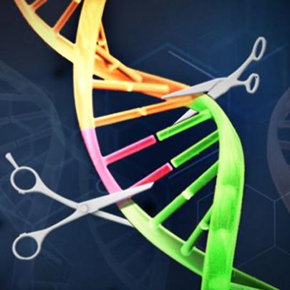Hank Greely is the Deane F. and Kate Edelman Johnson Professor of Law at Stanford University; Director, Center for Law and the Biosciences; Professor (by courtesy) of Genetics, Stanford School of Medicine; Chair, Steering Committee of the Center for Biomedical Ethics; and Director, Stanford Program in Neuroscience and Society.
Brie Linkenhoker is the director of Worldview Stanford, a project at Stanford University that creates media and learning experiences for public audiences. She is a member of St. Mark's Episcopal Church in Palo Alto, CA.
Brie Linkenhoker: You’ve worked on the legal and bioethical implications of a very wide range of issues. What thread connects them?
Hank Greely: I try to figure out what new technologies are coming down the road that are likely to have substantial social effects, what those effects are, and ways we might try to mitigate their potential risks and maximize their potential benefits. I look for things that are relatively likely to happen, and that are going to have a social impact, but I also make room, from time to time, for things that are just cool.
The things that I work on tend to be things that are realistic. I'm not very interested in abstract speculation. If I don't think a biomedical advance has a good chance of happening in the next 20 or 30 years, I'm not going to pay much attention to it.
 |
|
Hank Greely.
|
What are some of those things — the ones you think aren’t so likely to happen — but that might be getting a lot of attention nevertheless?
There's been a lot of press about extending human longevity maybe to the point of immortality. And there's a lot of money pouring into it from some rich people in Silicon Valley who want to be immortal. I think if any humans are going to become immortal, I’m not sure I would pick them as the first!
To me, immortality flunks my first test of “is this really plausible in the next 20 to 40 years?” There are so many things that can go wrong, so many things we can die of. If you cured every case of cancer in the United States, and if no one died of cancer going forward in the US, that would add an estimated 3.7 years to life expectancy. That’s a long way from immortality.
I also think that people overestimate the possibility of genetic enhancement, at least in my lifetime. Again, because we just don't know enough about it. We can't make X-Men because we don't know the genes for superpowers. We don't even know the genes to make you taller.
Height is actually a really interesting example. You can predict a baby's height quite accurately. About 90% of the variation can be explained by knowing the adult heights of the two parents and whether the baby is a boy or a girl. Scientists have found something like 50 genes that influence height. All combined, they explain about 10% of the variation.
Maybe in ten years we’ll be able to explain 20-25% of the variance in height when we’ve identified 300 genes that affect height, but we’re not going to be able to make super tall babies anytime soon because we just don’t know enough.
Part of me wants to say, “Give us long enough and we'll understand it all,” but there are at least 23,000 genes that code for proteins in our bodies. If each one of those has, say, just four variations, how many combinations is that? Four to the 23,000th power. And that doesn’t even take into account the impact of our environment and experience. Even with a population of 7.3 billion, there aren’t that many people who will share the same variations.
I'm a big fan of genetics. I think it's going to tell us an awful lot. It's just not going to tell us anything near everything, and a lot of people think that it is.
So what are the more pressing biomedical issues that you think will have societal impacts in the next twenty years?
I published a book last year called The End of Sex and the Future of Human Reproduction (Harvard University Press, 2016), which examines the implications of advances in genetics, stem cell research, and assisted reproduction.
 |
“The End of Sex?” That’s quite a title.
To help everyone rest easy, one of the firmest predictions of the book is that in 20 to 40 years people will still be having sex in whatever ways they do today. But they're not going to be having sex nearly as much for the purpose of making babies. I predict in the book that in 20 to 40 years most people with good health coverage anywhere in the world are going to conceive their children in a clinic so they can make lots of embryos, test them genetically, and then decide which embryos to transfer into a uterus for possible pregnancy and birth.
The main driving force behind that will be health — people trying to avoid the birth of children with serious genetic diseases. But there may be other things that people try to select, like gender, cosmetic traits, or fairly weak correlations with behavioral traits like abilities in math, music, or sports.
What makes this story plausible is the confluence of two technologies, both of which intersect with reproduction. One is cheap, whole genome sequencing, which I expect will in 20 to 40 years be under $100 a sequence. Today you can use pre-implantation genetic diagnosis to test an embryo for a few specific genes related to very serious diseases. But with cheap, whole genome sequencing, you could know every gene in the embryo.
The second technology is related to stem cells. Today, the rate-limiting factor for pre-implantation genetic diagnosis is that you have to do in vitro fertilization (IVF), and IVF is a pain. It's expensive. It's unpleasant. It's somewhat risky for the woman involved because egg harvest is hard. That’s 90% of the cost of IVF.
But a technology called induced pluripotent stem cells could change that. This technology, invented in 2007 by Shinya Yamanaka from Japan, takes skin cells and turns them into cells that are pluripotent, that are able to turn into every cell type.
So you’re really kind of turning back the clock, making skin cells from an adult look and act like cells in an early embryo — cells that have the capacity to turn into neurons, blood cells, sperm, eggs, kidney cells, etc.
Right. This technology is so promising because you could take skin cells from a patient, turn them into these induced pluripotent stem cells, and then get them to differentiate into, say, kidney cells. Then you could put those cells back into the patient’s body and the immune system won’t attack them.
So, if you could take a person’s skin cells and turn into kidney cells, you might be able to treat kidney failure with a person’s own cells, rather than a transplant. And that would mean that you wouldn’t have to worry about rejection or having to take immunosuppressive drugs for life.
Yes, it’s very exciting. There’s lots of research effort and money going into this. Eggs and sperm are just another cell type, so it’s easy to imagine an infertile couple being able to produce sperm or eggs from their own skin cells.
I think the first market for that will be people who are infertile because of an accident, illness, or congenital problem, or because in the case of women at least, increased maternal age. People who can’t make eggs or sperm naturally will use this process to do so. But then other people will catch on, and realize that you can avoid having to harvest eggs the way it’s currently done in IVF, where you get on average 10–12 eggs at a time. If you make eggs from stem cells, the question is how many do you want? 10? 100? 1,000? A million?
So, then you combine this process with whole genome sequencing, and you can imagine giving parents the chance to make 100 embryos, starting with eggs made from skin cells. You could sequence the entire genomes of 100 embryos, and then choose which one or two to transfer to the uterus.
 |
|
Brie Linkenhoker.
|
That scenario seems plausible, promising, and frightening to me all at the same time. Making IVF easier, and indeed even possible, for infertile couples sounds wonderful, but there are obvious ethical issues — and probably some safety concerns, too.
I actually think the biggest ethical issue in all of this is the safety of any babies created from it. One reason I put this scenario at 20 to 40 years out is that I think we would need at least a decade's worth of safety testing. This process has worked in mice, but many of the mouse babies created this way have had problems.
To address the safety concerns, we will need animal trials in non-human primates, and rigorous FDA reviews. But even if we set rigorous safety standards, there will still be clinics in Tijuana or Macau or other parts of the world that will sell these services at high prices to desperate people willing to take risky measures. We already see it with stem cell clinics and anticancer clinics. The quacks will always be with us, and that's a problem.
The story so far is about being able to produce hundreds or thousands of embryos, screening their DNA, and choosing the one or two you like the best. But you also work on the implications of new technologies for gene editing, the process of cutting DNA and inserting, deleting, or replacing it with other DNA. How do those technologies fit into the picture?
New ways to edit DNA are going to have huge implications not only for humans, but also for all of life on earth. The main new technology is something called CRISPR, which is an acronym that stands for "clustered regularly interspaced short palindromic repeats," which is why everybody just calls it CRISPR!
It's not a new thing to be able to edit DNA. Arguably, it started here at Stanford with Paul Berg in the early 1970s with recombinant DNA. CRISPR has only been around for about five years, but what’s important about CRISPR is that it is many, many times faster, cheaper, easier, and more accurate than what came before.
There’s a lot of concern about using CRISPR to make babies. I think this is less of an issue in the near term because for most diseases rooted in genetics, you can create embryos through IVF and choose those that don’t have the disease genes. You can do that today with proven, safe technologies. Altering DNA with CRISPR is much riskier. If you have a technology that makes 98 healthy babies, and two unhealthy ones, that’s a disaster.
So what are the more pressing issues with CRISPR and related technologies?
Consider mosquitoes. If you have a technology that makes two healthy mosquitoes and 98 unhealthy ones, not only don't people care, they applaud — if they pay any attention at all. We don't care as much about safety with respect to nonhumans.
Already researchers around the world have used CRISPR to make dogs that have more muscles, micropigs, and cashmere goats that have longer hair. You can imagine using CRISPR to bring extinct species back to life. You find the genome of wooly mammoths, compare it to the genome of Asian elephants, and start changing Asian elephant genes to be more mammoth-like. George Church at Harvard is doing this right now. And I think it’s only a matter of time before somebody makes a unicorn. Somebody is going to figure out the genes for horn growth and add them to a horse and make a unicorn. That's really playing with life and CRISPR allows us to do that.
Gene editing lets us have an unparalleled, unprecedented degree of control over the DNA of every living thing, and maybe the most important aspect of it is a form of CRISPR called gene drive, when you edit the DNA of sexually reproducing species to make a new gene spread through the species much faster than it ever would through evolution.
For example, maybe you’d like to make mosquitoes that don’t get malaria. If mosquitoes don’t get malaria, people won’t get malaria. With old forms of gene editing, you would make a bunch of mosquitoes that had two genes for malaria resistance and you would put them out to breed with mosquitoes that had no genes for malaria resistance. You would get a bunch of hybrids, but you would have to keep adding new mosquitoes, and it would take a long time to make a difference.
With gene drive, the CRISPR stays in the subsequent generations. So instead of making a bunch of hybrids in that first generation of breeding, the hybrids’ genes will be changed by CRISPR so that both genes are non-malarial. That change will happen in every baby mosquito in that first generation, and in every baby mosquito that generation has. You could, in theory, change the entire world’s population of Anopheles mosquitoes in a few years.
That could be a great thing. It could also be a really bad thing if you make a mistake, or if the gene drive goes in the wrong place, or if it turns out that mosquitoes having malaria has some really important positive benefits we don't know about.
What makes me so worried about this kind of thing is that it doesn't take a Stanford or a Monsanto or a Merck to do this. It takes a guy with a garage and about $1,000. CRISPR has in some ways made gene editing too easy. Anyone can do it, which means, I'm afraid, that anyone will.
We can’t regulate everyone with a garage and $1000. What can we do?
We need to think about regulatory structures that will work not just with big companies, universities, and research institutions, but that might have a chance of working with lone wolves in their garage labs. That's going to be hard.
We also need to think about what we want to regulate and how. What kinds of testing do you want before you put mosquitoes that have been genetically modified into the wild?
Maybe the most important thing we need to pay more attention to is planning for how to clean up. What if it turns out to be a mistake? Are there good ways we can spot the genetically modified mosquitoes? People have talked about kill switches that might be able to eliminate them with particular ease. And though they are far less exciting, we need insurance requirements to make sure that people who put altered organisms out there have some ability to pay if they cause damage.
We’ve covered everything from changing the global mosquito population to making unicorns to making babies from skin cells. What role should regular, everyday people — not the ones altering mosquito genes in their garages — play in figuring out which applications of these technologies are ethically acceptable?
On a personal level, people are going to have to decide, "do I want to do this for my babies or not? Do I want to try to convince my kids that they should or shouldn't use these technologies?" In that sort of personal-level decision, the more you know about it, the better. Maybe you can wait until shortly before the moment of decision, but it would be good to have some background before you, say, decide to start a pregnancy using these technologies.
At the societal level, there will be political decisions decided by the governing system of whatever country you're in. We have to decide as cultures, as governments, as people, what we want our culture to allow and not allow. I worry a lot about knee-jerk, emotional reactions, and about the problems of insufficient education.
Education isn’t a panacea. It’s not sufficient. But we have to try to educate both individuals and the professionals who will be involved directly in decision-making. Obviously, legislators would be nice, but you also need to educate judges, lawyers, doctors, journalists, and other people who will make or influence decisions.
What about religion? Whether that's religious faith in individuals, or religious institutions, or religious scholarship, what role can religion fruitfully play in helping society navigate these issues?
One obvious role is counseling, advising, or clarifying religious truths to believers in the religion. I think it is right for a religious body to try to come up with advice for their believers that is consistent with the religion's tradition. But I also think there’s a broader role for religious leaders or institutions that are thoughtful about long-term, deeper issues that will impact humanity. Those perspectives can be useful even to people who belong to different religions or who, like me, aren’t religious people at all.
Image credits: (1) Stanford Law School; (2) Genetic Literacy Project; and (3) Stanford Strategic Decision and Risk Management.


